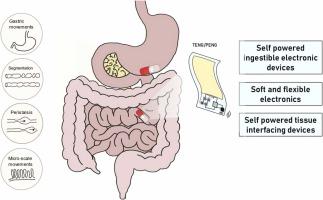生物机械能作为可消化装置的动力源
IF 17.1
1区 材料科学
Q1 CHEMISTRY, PHYSICAL
引用次数: 0
摘要
可摄入装置已成为对胃肠道(GI)进行无创实时生理变化监测的有用工具,并有可能用于肠道采样、药物输送和物理和化学传感。目前,大多数可消化的电子设备依靠电池为功能电子单元供电,然而,电池的存在使这些设备体积庞大,同时在生物相容性方面构成风险。在这篇综述中,通过全面讨论沿着胃肠道发生的机械运动的频率和相关力,胃肠道内固有的生物力学运动作为可消化装置的电源,作为电池的替代品。随后讨论了各种可用于胃肠道的微型可食用和可植入机械能收集装置的设计和性能,重点讨论了装置的开发、机电输出和体内性能。此外,还讨论了与能量收集装置接口的柔性电子器件,用于电源管理。最后,讨论了胃肠道机械能收集装置机电特性的现状和挑战,并对此类装置的标准化测试进行了展望。本文章由计算机程序翻译,如有差异,请以英文原文为准。

Biomechanical energy as a power source for ingestible devices
Ingestible devices have become useful tools for non-invasive monitoring of the gastrointestinal (GI) tract in real-time for physiological changes and potentially for intestinal sampling, drug delivery and physical- and chemical sensing. Currently, most of the ingestible electronic devices rely on batteries to power the functional electronic units, however, the presence of batteries makes these devices bulky while posing a risk in terms of biocompatibility. In this review, inherent biomechanical movements within the GI tract are presented as a power source for ingestible devices as an alternative to batteries by comprehensively discussing the mechanical movements occurring along the GI tract in terms of their frequency and associated forces. This is followed by discussions on design and performance of various miniature ingestible and implantable mechanical energy harvesting devices that can be applied in the GI tract with a focus on device development, electromechanical output and in vivo performance. Further, discussions are presented on flexible electronics that are interfaced with the energy harvesting devices for power management. Finally, the current state and the challenges of electromechanical characterization of mechanical energy harvesting devices for the GI tract are discussed along with a perspective on standardized testing of such devices.
求助全文
通过发布文献求助,成功后即可免费获取论文全文。
去求助
来源期刊

Nano Energy
CHEMISTRY, PHYSICAL-NANOSCIENCE & NANOTECHNOLOGY
CiteScore
30.30
自引率
7.40%
发文量
1207
审稿时长
23 days
期刊介绍:
Nano Energy is a multidisciplinary, rapid-publication forum of original peer-reviewed contributions on the science and engineering of nanomaterials and nanodevices used in all forms of energy harvesting, conversion, storage, utilization and policy. Through its mixture of articles, reviews, communications, research news, and information on key developments, Nano Energy provides a comprehensive coverage of this exciting and dynamic field which joins nanoscience and nanotechnology with energy science. The journal is relevant to all those who are interested in nanomaterials solutions to the energy problem.
Nano Energy publishes original experimental and theoretical research on all aspects of energy-related research which utilizes nanomaterials and nanotechnology. Manuscripts of four types are considered: review articles which inform readers of the latest research and advances in energy science; rapid communications which feature exciting research breakthroughs in the field; full-length articles which report comprehensive research developments; and news and opinions which comment on topical issues or express views on the developments in related fields.
 求助内容:
求助内容: 应助结果提醒方式:
应助结果提醒方式:


